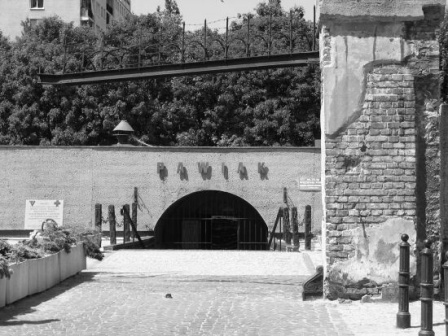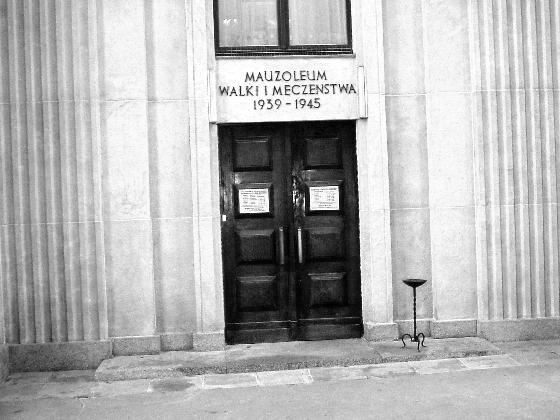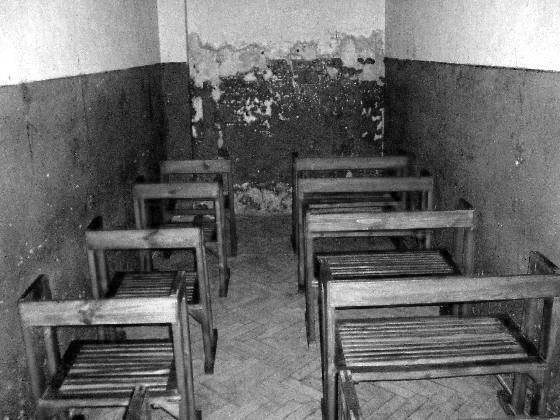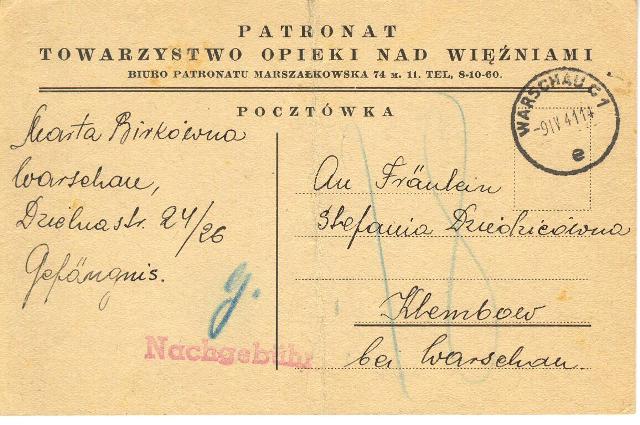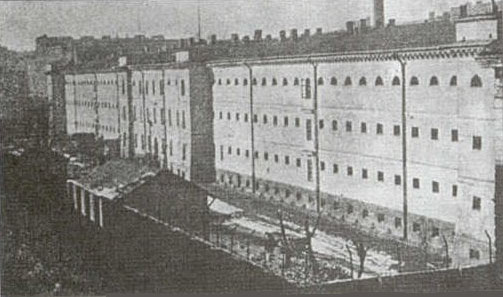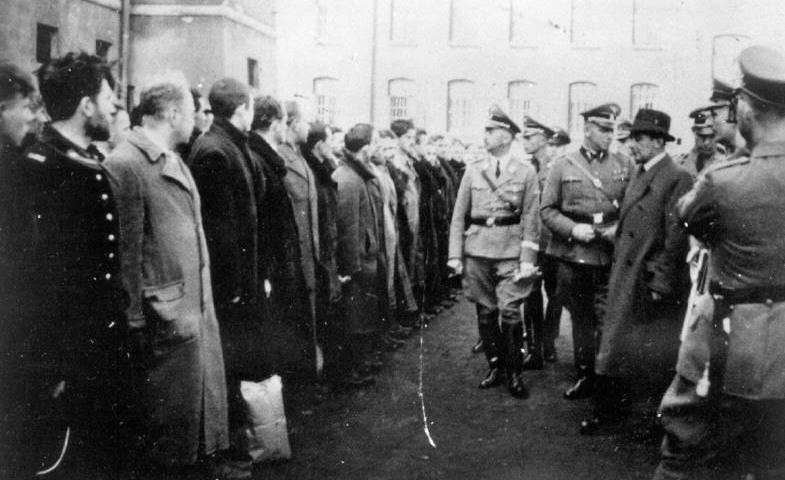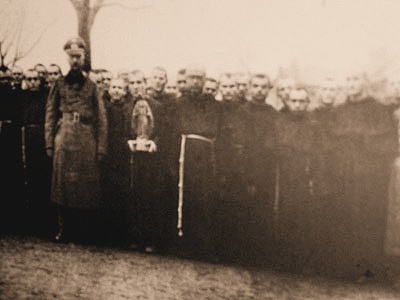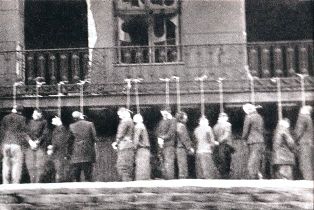Holocaust Education & Archive Research Team |
|
Occupation German Occupation of Europe Timeline
-
[The Occupied Nations]
Poland Austria Belgium Bulgaria Denmark France Germany Greece Hungary Italy Luxembourg The Netherlands Norway Romania Slovakia Soviet Union Sudetenland
| ||||
Gestapo Headquarters Szucha Avenue and Pawiak Prison -Warsaw
Gestapo Headquarters – 25 Szucha Avenue, Warsaw The Gestapo Head Quarters at 25 Szucha Avenue was one of the most feared buildings in Warsaw, its very name one that provoked fear and dread amongst the population of Warsaw.
In the basement or on the upper floors of this building prisoners were beaten up and abused, by Gestapo men, and suspects were placed blood stained in isolated cells, or collective cells, the latter which were called “trams” by the prisoners.
Many Poles lost their lives in this gloomy institution of terror, bodies of murdered and dying people littered the corridors, thrown there by Gestapo thugs.
Jozef Garlinski, a member of the Home Army - Polish Underground recalled his arrest after climbing off a tram, on 20 April 1943.
“ Suddenly I was conscious of someone behind me. Then I heard footsteps. As I turned my head, I heard – “Halt! Hande Hoch! Two young men rushed towards me, the dark metal of revolvers in their right hands”.
We went down Litewska Street. A man came out of a gateway and followed us at a convenient distance. We had crossed the frontier into the undisputed territory of the Germans.
We turned left and again left and entered a building up several steps. We were in Gestapo headquarters.
In the dark anteroom the windows of the spacious inquiry office sparkled and inside a sleepy NCO on guard sat by the telephones. The man escorting me said a few words to him and pointed to the stairs on the left, leading down to the cellars.
We went up to the iron bars and my guard rang a bell. Keys rattled and a dishevelled NCO in bedroom slippers opened them. My guard whispered a few words and quickly withdrew. The bars grated open then shut.
The NCO gave me a bored look of dislike. Komm.
We turned left along a pale narrow corridor, rather poorly lit. The left- hand wall consisted of iron gratings, which formed the doors of four windowless cells. This must be the famous tramcar I thought.
I knew the Gestapo building fairly well from the numerous reports I received.
Beyond the last cell was a small room with a typewriter and a large wireless set. I felt myself growing tense”.
After an initial interrogation Garlinski was led to the tramcars.
“ I sat down quickly on a bench with my face to the wall. This was the cell ‘mit musik’ it was only separated by a wall from the room with the wireless. The bench made out of narrow boards was small and uncomfortable. But we had to sit still for behind our backs, on the other side of the bars, a guard paced up and down, observing us constantly. Anyone who attracted his attention was led out to do ‘gymnastics’ from which he returned breathless and with reddened cheeks.
At last the little room with the radio came to life too. A cheerful tune rang out, mingled with the noise of the typewriter. Names began to be called out. The cell ‘mit musik’ became quiet. In the little room next to it the radio was turned off and the occupants got down to work.
One could hear curt questions, the murmur of low answers and again and again, the sound of blows, after which came a shriek, often a women’s sob, clutching at our hearts and impeding our breathing”.
Soon it was Garlinski’s turn:
“It was nine o’clock when my turn came. In the room were the two Gestapo men who had been there yesterday, as well as a big fellow in uniform and a small dark curly-haired civilian with a sullen look. He addressed me in good Polish.
After a brutal interrogations with beatings with a hide whip, Garlinski was pushed back into the tramcars for eight hours, after having revealed very little about himself.
It would appear that he had been arrested by the Gestapo in a case of mistaken identity.
“ At five in the afternoon the guard read out several names. We were stood side by side and led through a maze of corridors onto the courtyard.
There was a black van waiting for us. It was with some relief that I discovered we were going to the Pawiak Prison.
We were strongly escorted the horns blowing loudly and, as it was six o’clock in the evening and the city at its liveliest, trams stopped and cars got out of the way. A wall, a barrier.
Over the ghetto rose clouds of smoke. I was arrested on 20 April 1943 and one day earlier the Germans started the final assault on the Jewish district and were greeted by fire from small arms and grenades. The Jewish Fighting Organisation had started to resist.
We were under a black canvas hood, but it was possible to see a little. The gloomy blocks of houses, standing close together, were shaken every moment by the nearby detonations of shells. From inside came shrieks, smothered by wild firing.
The barrier had been raised to let in our column of cars. We raced through the deserted streets, past a group of gendarmes and SS men crouching behind a wall, past some corpses. Finally, the crazy barking of dogs, the curses and shouts of the Gestapo men, “Raus, Raus” (Get Out).
We had reached the Pawiak Prison, an island in the midst of the stormy sea of the fighting Ghetto.
Pawiak Prison – 24/26 Dzielna – Warsaw
A decision to erect a new prison in Warsaw was taken in 1829. The prison later called Pawiak was located between Dzielna, Pawia and Wiezlenna Streets. The construction works started in 1830 and were completed in 1836.
The buildings were designed by Henryk Marconi , official builder and one of the most outstanding Polish architects of the 19th century. The first inmates were imprisoned in 1835.
The prison had a rectangular shaped plot occupying an area of 1.5 hectares, surrounded by a wall with two turrets on the Dzielna and Pawia Street sides. The main building which contained the men’s section, consisted of four storeys. The women’s prison known as “Serbia”, had three storeys.
The complex also included various auxiliary buildings, such as warehouses, workshops, a kitchen, storerooms, baths, a boiler house, potato treatment rooms and a laundry.
During the first period under the Nazi occupation, until March 1940, the prison was subordinated to the Department for Justice of the Generalgouvernement. From March 1940 Pawiak became a prison under the control of the Commander of the Security Police, SD and Gestapo.
At the beginning of November 1940 permanent German staff took up duties in the prison. This affected the conditions within the prison, as Polish warders had tried to help the inmates in various ways, including facilitating contacts with the outside world. The Polish warders were arrested between March and April 1942.
Joe Heydecker a German soldier described a house that was near the prison:
“There were about twenty people. Most of them slept on the bare parquet floor on blankets or newspapers covering themselves with coats. In one corner sat a woman trying to comfort a crying child. Then it struck me that in this room there were only women, girls and children. At a glance one could see their deprivation, the absence of any hygienic facilities, and their wretchedness.
The cold air was suffocating. The windows were shut and nailed down, the glass in them had been painted over with thick blue paint. Later I learnt that the windows had been nailed down and painted over because they looked out onto the Pawiak, the prison of the German Gestapo and SD. The name Pawiak struck terror in the heart during the German occupation of the city.
The whole building complex bordered onto the back of Dzielna Street and would have afforded a view into it from the windows at the back of the house. “We always hear the shooting”, one of the people in the room told me. “Often during the day, more frequently at night, and screams too, when the city is quiet”.
Pawiak was designed to accommodate 1,000 inmates, housed three times that amount, the conditions in the prison was extremely harsh.
One prisoner recalls:
“Although a small grated window was open at all times, the air inside the cell was unbearably stuffy – a nasty chill in winter and an equally nagging heat during the summer months. Despite frequent delousing – bedbugs and fleas made inmates lives miserable”.
Food at Pawiak was insufficient throughout the entire period of the German occupation. The worst situation was in the second half of 1941, and during the whole of 1942. Without aid from the outside prisoners would have starved to death.
The first public execution in Warsaw was closely linked with Pawiak, the announcement of 3 November 1939 informed the population about the execution of Ms Eugenia Wlodarz and Ms Elzbieta Zahorska who were arrested for tearing down a German propaganda poster reading “England this is your work”. They were imprisoned at Pawiak and later executed at Fort Mokotowski.
Around two hundred and fifty Pawiak prisoners were executed between 1939 – 1944 in Warsaw and its surrounding areas, such as Bukowiec, Palmiry, Wolka Weglowa, Luze, Laski, Magdalenka, Stefanow, Las Kabacki, Wawer and Anin. The executions reached their climax in 1943 and 1944, after the Ghetto had been liquidated executions were carried out in the streets near the prison.
An inmate recalls:
“During the ghetto uprising in April – May 1943 Pawiak became an assault base for the Nazis. Prison warders under the command of Burkl, volunteered to hunt for insurgents. Captured victims were beaten, humiliated and ill-treated. Then they were shot dead at point blank range in the back of their heads. Men and women alike.
Also the Ukrainians did the same, later like their masters, they returned excited by murder. We looked at their faces with disgust – we were petrified to hear their tales. In Pawiak the cells were filled with acrid smoke. We could smell human bodies burning. Iron cupboards and beds were scorching. Rubber soles turned into balloons. Apparently, we would also go up in flames”.
After the final liquidation of the ghetto in May 1943 Jews captured in the Aryan part of the city were brought to Pawiak prison marked with a plus sign and immediately thrown in dark, dirty bed-bug infested cells in Section Vlll. Executions were carried out nearly every day, in the ruins near the prison.
The Directorate of the Civilian with the co-operation of the Polish Home Army and the clandestine prison unit, pronounced death sentences on a number of Gestapo men from both the Pawiak Prison and Szucha Avenue. Hans Burkl, deputy commander of Pawiak, a sadist and multiple murderer, was shot dead on 7 September 1943 by soldiers from the Agat detachment at the corner of Marszalkowska and Litewska Streets.
During 1943 and 1944 soldiers of the Home Army executed other members from Pawiak Prison and the Gestapo headquarters, including:
Some of the infamous SS men who served at Pawiak
Following the last group of executions on 13 and 18 August 1944, German sappers blew up the prison on 21 August 1944. Today a few remnants of the former prison complex can be seen at the Pawiak Prison Museum.
Sources:
Szucha Avenue – Mausoleum of Struggle and Martydom The Survival of Love – Jozef Garlinski Pawiak 1835 –1944 – Museum Guidebook The Warsaw Ghetto – A Photographic Record 1941-44 – Joe J Heydecker
Copyright H.E.A.R.T 2007
|
Remember Me | Special Thanks | Holocaust Links | Publications
© 2013 H.E.A.R.T All Rights Reserved.
